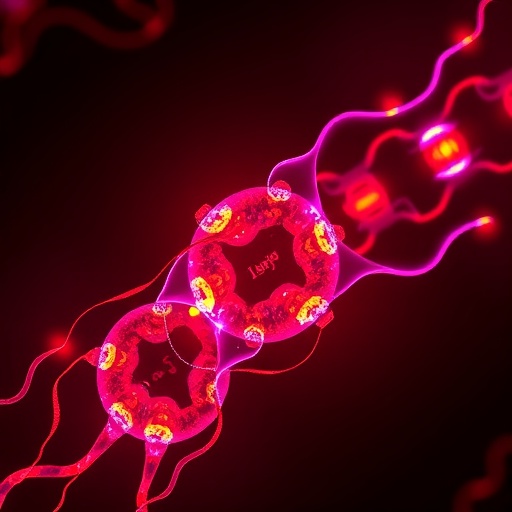In a groundbreaking study that promises to enhance environmental sustainability, researchers have developed a novel method for the degradation of rhodamine B (RhB) dye in aqueous solutions using a combination of antimony trisulfide (Sb2S3) and magnetic activated carbon. In the world of photodegradation, particularly within the ambit of environmental science, efficient degradation methods are crucial for mitigating pollution caused by synthetic dyes and their hazardous impact on aquatic ecosystems.
Rhodamine B, a synthetic dye commonly used in textiles, poses serious environmental risks due to its persistent nature and toxicity. Traditional methods for removing such contaminants often fall short, necessitating the development of innovative approaches. The recent findings presented by Afzia and colleagues indicate that employing Sb2S3 in conjunction with magnetic activated carbon provides a potent solution for enhancing visible light-driven degradation processes.
Magnetic activated carbon has drawn considerable attention due to its unique properties, including high surface area, porosity, and the ability to be easily separated from mixtures using an external magnetic field. These characteristics make it an ideal candidate for environmental remediation applications. Researchers have been keen to explore its potential in catalyzing photodegradation reactions, especially those reliant on visible light, which is abundant and accessible compared to ultraviolet light.
The essence of the research lies in the synergistic effects observed when combining Sb2S3 with magnetic activated carbon. This hybrid material not only enhances the efficiency of the photodegradation process, but also allows for the harvesting of visible light, a significant advantage in settings where traditional UV-based methods are impractical or expensive. The ability of this hybrid system to work effectively under visible light opens new avenues for practical applications in wastewater treatment and pollution remediation.
The study meticulously details the photodegradation mechanism, highlighting that the presence of Sb2S3 plays a critical role in generating reactive oxygen species (ROS) upon illumination. These ROS are pivotal as they facilitate the breakdown of recalcitrant dye molecules, including RhB. The catalyst’s ability to absorb visible light enhances the photonic activity significantly, thus leading to accelerated degradation rates.
Moreover, the research underscores the significance of optimizing various parameters, including catalyst loading, pH, and initial dye concentration, to achieve maximum degradation efficiency. The authors present compelling data showing that under optimal conditions, the degradation efficiency of RhB could surpass that of conventional methods, making it a viable option for large-scale applications.
Another intriguing aspect of this research is the regeneration of the magnetic activated carbon catalyst. The team conducted tests to evaluate the catalyst’s stability and reusability over multiple degradation cycles. The results were promising, indicating that the catalyst retains its integrity and effectiveness even after several uses. This durability is a crucial factor in evaluating the feasibility of implementing this technology in real-world applications, where cost and longevity of materials are paramount.
To address potential ecological impacts of this method, the researchers conducted a toxicological assessment of the by-products generated during the degradation process. The findings suggest that not only is the initial pollutant effectively removed, but the resultant compounds are significantly less toxic, supporting the environmental remediation potential of this approach.
The implications of this research extend far beyond just dye degradation. Given that a multitude of organic pollutants share similar structural characteristics with RhB, the developed method could be adapted for broader applications in wastewater treatment, addressing other contaminants that are equally resistant to conventional degradation strategies.
Furthermore, the integration of magnetic materials in catalysis introduces an additional layer of practicality to the process. The ease of separation and recovery reduces operational costs, making the approach not only effective but also economically viable. This balance of efficiency and sustainability aligns perfectly with the global push toward greener technologies.
As the research community continues to grapple with the challenges posed by environmental pollutants, studies like this illustrate the power of innovative materials and methods in addressing these pressing issues. The development of Sb2S3-modified magnetic activated carbon could mark a significant step forward in creating more effective and sustainable solutions for pollutant removal.
In conclusion, the work conducted by Afzia and colleagues opens new pathways for managing environmental pollutants through advanced degradation techniques. As urbanization and industrial activities increase, so does the need for effective remediation strategies. Their findings serve as a clarion call for further exploration into hybrid materials and photodegradation processes, shedding light on the potential for innovative solutions to create cleaner, healthier ecosystems.
In the unfolding narrative of environmental science, the marriage of cutting-edge materials science with ecological conservation offers a glimmer of hope for a future where clean water and thriving aquatic ecosystems are the norm, rather than the exception. The implications of this research are profound, signaling a shift toward more sustainable practices that prioritize the health of our planet.
This study underscores the importance of interdisciplinary collaboration and innovative thinking in addressing global challenges, reinforcing the idea that scientific advancements can lead us to novel solutions for some of the most pressing environmental issues of our time.
Subject of Research: Degradation of Rhodamine B using Sb2S3 modified magnetic activated carbon.
Article Title: Enhanced visible light degradation of RhB in aqueous solution by using Sb2S3 modified with magnetic activated carbon.
Article References:
Afzia, M., Ismail, B., Arooj, A. et al. Enhanced visible light degradation of RhB in aqueous solution by using Sb2S3 modified with magnetic activated carbon. Environ Sci Pollut Res (2025). https://doi.org/10.1007/s11356-025-36827-0
Image Credits: AI Generated
DOI:
Keywords: Photodegradation, Rhodamine B, Sb2S3, magnetic activated carbon, environmental remediation, wastewater treatment.




